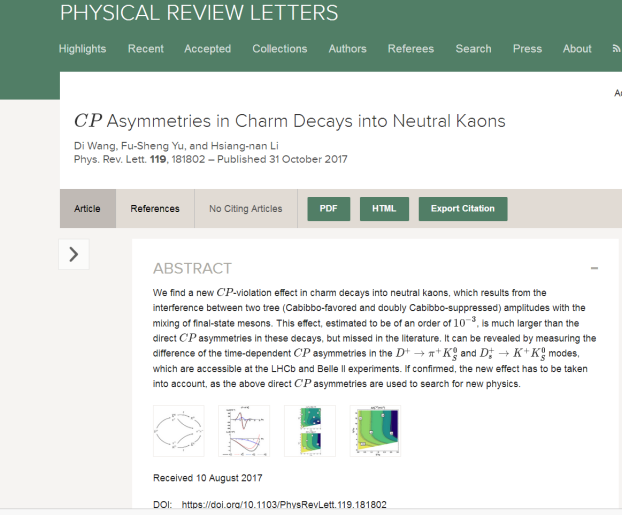An Important Research Result of Associate Professor Yu Fusheng's Research Group of Lanzhou University Was Published in PRL
An Important Research Result of Associate Professor Yu Fusheng's Research Group of Lanzhou University Was Published in PRL

'CP asymmetries in charm decays into neutral kaons' is what Yu Fusheng, associate professor of the School of Nuclear Science and Technology of Lanzhou University, published recently. The research results were completed by the research team of Associate Professor Yu Fusheng of our University in cooperation with Professor Li Hsian-nan of the Central Research Institute of Taiwan. Associate Professor Yu Fusheng was the first corresponding author and graduate student Wang Di was the first author.
Particle - antiparticle symmetry destruction (CP destruction) has always been an important frontier subject in particle physics and nuclear physics. CP destruction effect has been found in the decay process of both exotic quark particles and bottom quark particles (experimental discoverers and theoretical interpreters have won the Nobel Prize in physics respectively), and it has been a difficult problem in particle physics to find CP destruction phenomenon of charm physics in the decay process of charm quark particles.
Yu Fusheng and his collaborators have been engaged in the research of charm zone-related decay mechanism and CP damage for a long time. The factor-assisted topological graph method proposed by them is the most effective theoretical method to understand charmonium decay in the world at present, and the CP destruction value obtained by this method establishes the importance and observability of the new CP destruction effect. In particular, PRL's review comments emphasized that the study was unprecedented and gave great affirmation to the measurement method proposed in the paper. The new CP destruction effect can be observed in LHCb experiment of large hadron collider at CERN and Belle II experiment in Japan. The research was funded by the national natural science foundation of China.
Paper Link: https://journals.aps.org/prl/abstract/10.1103/PhysRevLett.119.181802



